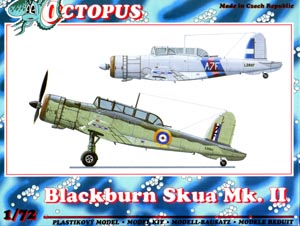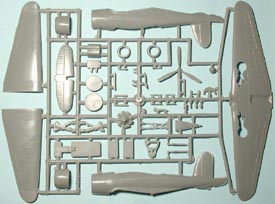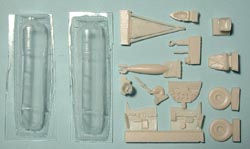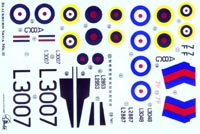Octopus’ 1/72 Blackburn
B.24 Skua Mk. II |  | History The Blackburn Skua was the first all-metal monoplane for the Fleet Air Arm and held several unique records. On September 26, 1939, Skuas from No. 803 Squadron scored the first kill of the war when they shot down a German Do 18 flying boat. On April 10, 1940, Skuas from No. 800 and No. 803 Squadrons also sank the largest German ship at the time, the cruiser Königsberg, when it was off the coast of Norway. The Skua was also the first fighter to use ship-based radar homing to an enemy target.
The Fleet Air Arm ordered the first prototypes of the Skua in April of 1935 and on February 9, 1937, the first took its first flight. Eight months earlier, the FAA ordered 190 Skuas straight off the drawing board. A Bristol Perseus XII engine rated at 830hp powered the Skua, and armament consisted of 0.303 machine guns in the wings and rear cockpit. The Skua carried a single 227kg bomb underneath the fuselage, which rounded out the armament package.
The performance of the Skua was inadequate by the time it entered service and it was only through the bravery of their crews that they achieved any success in the battles over Norway. The Kit  Octopus (nee Pavla) kit of the Skua was not entirely unexpected, as they did release a Blackburn Roc kit a few years ago. The two planes had much in common, and these two kits have much in common as well. This kit is a great improvement over the old Frog kit, so if a Skua is on your list of planes to build, this is the one to get. In the box you get a handful of resin detail parts, a single large sprue of gray parts, and a clear vacuformed canopy. The kit has recessed panel lines throughout and the detailing is quite good. Octopus (nee Pavla) kit of the Skua was not entirely unexpected, as they did release a Blackburn Roc kit a few years ago. The two planes had much in common, and these two kits have much in common as well. This kit is a great improvement over the old Frog kit, so if a Skua is on your list of planes to build, this is the one to get. In the box you get a handful of resin detail parts, a single large sprue of gray parts, and a clear vacuformed canopy. The kit has recessed panel lines throughout and the detailing is quite good.
Starting with the interior, this is almost entirely made up from the resin parts. Plastic pieces make up the floor, central bulkhead frame, and fuel tank, with resin providing the seats, control stick, sidewall inserts, rudder pedals, and instrument panel. The level of detail in the finished cockpit is very good and will look great under that clear vacuformed canopy. The only addition left for the modeler is a pair of bracing struts going from the central bulkhead frame to the end of the fuel tank, and the instructions are quite clear on how long these should be. The engine assembly comes next and this is straightforward. The engine is molded in plastic as one piece, so detail freaks might think about replacing it with an aftermarket engine. The front bracing needs to be added from 0.3mm rod, with the  instructions once again providing the proper dimensions. The cowling is split into right and left halves, and the propeller is molded as one piece with a separate hub and shaft. instructions once again providing the proper dimensions. The cowling is split into right and left halves, and the propeller is molded as one piece with a separate hub and shaft. The wings come in three pieces, with a one-piece lower wing providing the proper dihedral. The wheel wells are made up of separate pieces, blanking them off nicely. The landing gear has an odd stance to it, but the instructions are very clear as to the positioning of all the parts. A total of six parts make up each main gear assembly, resulting in an accurate-looking undercarriage. Also underneath the wing is the bomb and cradle, and the resin bomb looks quite nice. The rest of the assembly is very straightforward. The fuselage is split into right and left halves, and the horizontal tailplane is molded as one piece. There is an insert for the rear fuselage for the tailhook, with the hook itself cast in resin. A separate tailwheel and strut, and an antenna for the cockpit roof, just about finish this model off.  The decal options in this kit provide no less than four choices, all interesting options. The first one is from No. 803 NAS and was flown by Lt. Collingham, who shot down a Heinkel He 115 with this aircraft. It is finished in a camouflage of medium sea gray and dark green over sky, with the wings split black and white on the underside. The second option is for those who want something that stands out, as it’s a target tug of No. 20 Maintenance Unit. Standard target tug colors apply, namely yellow overall with black diagonal lines on the fuselage and wings. The third choice is another camouflaged plane, this time in Dark Slate Gray and Extra Dark Sea Gray over Sky. Finally, the last option is from the Spring of 1939 and is a silver Skua of No. 803 NAS, complete with colored fuselage bands. The decals are well printed and in excellent register. The decal options in this kit provide no less than four choices, all interesting options. The first one is from No. 803 NAS and was flown by Lt. Collingham, who shot down a Heinkel He 115 with this aircraft. It is finished in a camouflage of medium sea gray and dark green over sky, with the wings split black and white on the underside. The second option is for those who want something that stands out, as it’s a target tug of No. 20 Maintenance Unit. Standard target tug colors apply, namely yellow overall with black diagonal lines on the fuselage and wings. The third choice is another camouflaged plane, this time in Dark Slate Gray and Extra Dark Sea Gray over Sky. Finally, the last option is from the Spring of 1939 and is a silver Skua of No. 803 NAS, complete with colored fuselage bands. The decals are well printed and in excellent register.
Conclusion This is easily the best Skua kit on the market today and with a bit of work it should build up into a nice replica of this unique fighter. If you are into FAA aircraft, you should not pass up this one. | 








|
